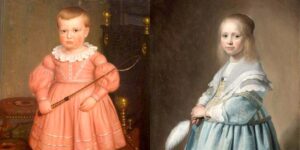
BARBIECORE ORIGINS
Barbiecore began to take shape when Mattel released the original Barbie Doll on March 9, 1959. I remember getting my first one in the fall of that year. Ken showed up in 1961, her friend Midge (1963), and little sister, Skipper (1964). However, it was not until 1980 that Barbies resembled women of color.
I don’t remember getting Ken or any of the others because I really didn’t play with dolls that much. Interestingly enough, it wasn’t until the 1970s that pink became her color. Now, Mattel has a copyrighted Pantone shade called Barbie pink (219 C), a deep and bright shade of the rosy hue.
BARBICORE WASN’T ALWAYS FOR GIRLS
Until the 1940s, pink was for boys and blue was for girls. (Who knew?) Blue was associated with the Virgin Mary and pink, because of its association with the strong, masculine color—red—was recommended for boys.
Even as late as 1927, leading department stores such as Filene’s (Boston), Best & Co. (New York), Halle’s (Cleveland), and Marshall Field (Chicago) advised parents to dress boys in pink.
The change began after World War II when Mamie Eisenhower entered the White House. Pink was her favorite color. From her inaugural ball gown to her kitchen and furniture, Mamie embraced that color between white and red, and soon the residence became known as the pink palace. Mamie reflected the feelings of many post-war women who wanted to return to traditional roles. She is quoted as saying ‘Ike runs the country. I turn the pork chops!’ and ‘I have a career. His name is Ike.’”
Film star Jayne Mansfield picked up on the fashion, determined to show there was nothing masculine about her. “She explained that this was because ‘men want a girl to be pink, helpless, and do a lot of deep breathing.’”
By now, Americans were buying into the connection between wearing pink and women being delicate creatures. YIKES!
Celebrities touting pink and glittery ultra feminine outfits in the early 2000s, including Paris Hilton, Nicole Richie, and Brittany Spears, gave Barbiecore a big boost. Movie costumes followed the pink trend, including Legally Blonde, Clueless, and Mean Girls. Ariana Grande and rapper Nicki Minaj are now carrying the banner. Even Lizzo is getting into the game.
BARBIECORE AND ME
True confession time here. I don’t wear pink for the very reason Jayne Mansfield wanted to wear it—I do not want to convey that I am helpless, because I am not. Besides, pink is not a flattering color for me, while red is.
To me, it doesn’t mean confidence and happiness, just helplessness. After all, I am a child of Mamie Eisenhower’s universe, and I remember those days all too well.
Sign up on www.mariewatts.com to receive future Stories About Life delivered to your email address or read more stories by clicking here.


Recent Comments